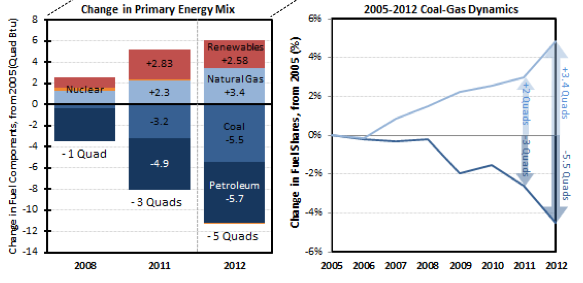On September 26, the U.S. State Department released its sixth Climate Action Report (CAR6). This report, published every four years as required by the United Nations Framework Convention on Climate Change (UNFCCC), projects how current U.S. actions will impact greenhouse gas emissions into the future. Currently in draft form, the CAR6 will be open for public comment until October 24.
Since the last Climate Action Report release in 2010, the U.S. has consumed less energy annually, resulting in fewer annual greenhouse gas emissions. Increased energy efficiency has reduced overall energy consumption, and the growing use of renewable energy sources has helped decarbonize the energy sector and reduce greenhouse gas emissions. The report notes the important impact that natural gas has played as more reserves are discovered and prices continue to decline. Energy generation from renewables has also grown as technologies for solar PV and wind move along their learning curves.
CAR6 is the first edition of the Climate Action Reports to include a Biennial Report that outlines how additional planned climate policies and measures will further reduce greenhouse gas emissions through 2020. President Obama’s future climate goals, which he outlined in his Climate Action Plan in June of 2013, include doubling the amount of electricity generation from renewable sources, reducing emissions from hydrofluorocarbons, developing a methane reduction strategy, and protecting America’s natural landscapes and habitats. Several planned policies to achieve these goals include fuel economy standards and fuel efficiency standards for the transportation sector, carbon pollution standards for power plants, energy efficiency standards for lighting and appliances, and air quality standards for the oil and gas industry. State and regional policy efforts, such as the Northeast’s Regional Greenhouse Gas Initiative (RGGI) and California’s Global Warming Solutions Act (AB 32), have also effectively contributed to the country’s emissions reductions. CAR6 notes that the combination of existing policies and the future climate actions from Obama’s Climate Action Plan put the U.S. on track to achieve President Obama’s goal to reduce greenhouse gas emissions by 17 percent below 2005 levels by 2020.
CAR6 further discusses the U.S.’s role in achieving global greenhouse gas reductions through international support. To ensure that the U.S.’s climate mitigation efforts have only positive effects on other countries, the country has committed to offering support for policy development, establishing public-private partnerships, and providing worker training. The U.S. has also mobilized private finance and invested strategically in countries that are still developing frameworks for future sustainable energy economies. In 2011 and 2012, the U.S. invested nearly $1 billion toward climate resilience practices in developing countries.


